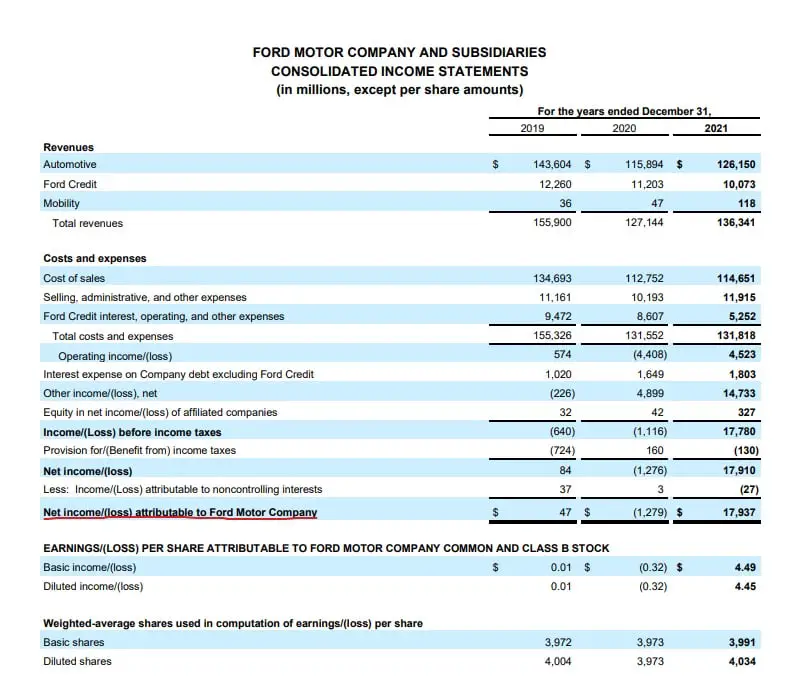In this article, we shall discuss net income, examples, and calculations. One key metric that can show a company’s profitability is the net income. It represents the total amount of money a company earns in an accounting period after deducting its expenses, taxes, and interest payments. It is found on the income statement of companies along with other components such as the cost of sales, revenue, and operating expenses. Publicly traded companies such as Ford motor company use net income when calculating earnings per share which determines the distributions that are paid to shareholders.
See also: Net Income vs EBIT Differences and Similarities
What is net income?
Net income is a company’s total profit after deducting all its expenses arising from the production of goods or provision of services as well as one-time payments for unusual events, taxes, and interest payments. It is also referred to as its bottom line, net income after taxes, net earnings, or net profit.
It is from the net income that companies save for future use, pay dividends to shareholders, make investments, carry out research and development of new products or services, or purchase assets. The net income of a company can be calculated monthly, quarterly, or annually; depending on how and when the company decides to calculate its net income. The net income of a company can be positive or negative. This depends on whether the company made a profit or incurred losses at the end of the accounting period in view.
When a company generates more revenue than its expenses, the company will have a positive net income. When the company’s expenses are more than its revenue, the company will have a negative net income or a net loss. Startups generally have negative net income within the first six months to a few years of operation. This changes as they make more sales and generate more income than expenses. Well-established and matured companies generally have a positive net income. However, some of these companies might have a negative net income if the company starts failing.
Some reasons why matured companies might start failing include a lack of proper growth and development plans, unsustainable business models, and poor fund management, amongst other factors that make a company’s expenses more than its revenue. When a company’s net income is negative for a protracted period, it leads to bankruptcy or the closing up of such a company. Financial institutions usually consider the net income of companies that are seeking loans so as to ascertain whether they are credit-worthy or not. Investors use it to gauge whether their investment in a company will yield benefits to them through dividend payments or not.

See also: Is Net Profit the Same as Net Income?
Net income formula
There are several metrics that are useful in tracking the financial health of a business and net income is one of these. It indicates whether the company made a profit or incurred a loss at the end of the accounting period. In order to calculate it, the net income formula is used. Since net income is the amount left after deducting all expenses from revenue, it can be expressed as Net income = Total revenue – Total expenses
This formula can be expanded to clearly show the total expenses as Net income = Total revenue – [(Cost of goods sold + Operating expenses + Non-operating expenses) + Non-operating income – Taxes]
Another variation of the net income formula is Net income = Gross income – Expenses
Where Gross income = Total revenue – Cost of goods sold
How to calculate net income
- In order to calculate net income, first find the total sales or total revenue generated by the company from the sale of products or services.
- Deduct the cost of goods sold (COGS) or cost of sales from the total revenue. COGS is the direct cost associated with creating goods or services. The result gotten is known as the gross income.
- Deduct operating expenses from the gross income. The operating expenses include all administrative expenses such as salaries, marketing, rent, research, utilities, depreciation, and amortization. The result gotten after the deduction is known as operating income.
- Deduct non-operating expenses from the operating income. The non-operating expenses are spendings that are not directly related to production; a common example is interest payment.
- Add any income generated from other sources aside from goods or services. This is known as non-operating income. Common examples include interest or dividends paid to the company for their investment.
- Deduct tax payments to arrive at the company’s net income.
Net income example
Using the above steps, let us have a look at an example of how to arrive at the net income and how it will look when you view the income statement of a company.
Assuming a dairy products manufacturing company such as Dairy Farmers of America (DFA) made sales of $500,000 during the last quarter of 2022. The cost of manufacturing during the period was $300,500, leaving a gross income of $199,500. The operating expenses of DFA came to $98,700, resulting in an operating income of $100,800. Then the Dairy Farmers of America subtracted $29,300 in interest expense and added $18,600 in interest income, yielding a net income before taxes of $90,100. The company’s total tax payment of $12,495 was then subtracted. Thus, the net income of Dairy Farmers of America for the last quarter of 2022 is $77,605.
This information can be tabulated as follows:
| Calculating net income | Dairy Farmers of America |
|---|---|
| Total sales | $500,000 |
| – Cost of sales | – $300,500 |
| = Gross income | $199,500 |
| – Operating expenses | – $98,700 |
| = Operating income | $100,800 |
| – Non-operating expenses | – $29,300 |
| = Gross income minus expenses | $71,500 |
| + Non-operating income | + $18,600 |
| = Net income before taxes | $90,100 |
| – Taxes | – $12,495 |
| = Net income | = $77,605 |
See also: Net Income vs Net Earnings Differences and Similarities

Net income calculation
Now that we have had a look at the net income formula and the steps involved in the calculation process, let us look at some examples of how one can arrive at their company’s net income.
Example 1
Assuming a retail pet feed manufacturer wants to find their net income for the month of November and has the following information:
- Sales: $60,000
- Cost of sales: $20,000
- Utilities: $2,000
- Rent: $6,000
- Salaries: $10,000
- Marketing: $100
- Interest expense: $1,000
- Taxes: $780
Using the information above, we can calculate the company’s net income using Net income = Gross income – Expenses
Where gross income = Sales – Cost of sales = $60,000 – $20,000 = $40,000
Expenses = Utilities + Rent + Salaries + Marketing + Interest expense + Taxes = $2,000 + $6,000 + $10,000 + $100 + $780 = $18,880
Net income = $40,000 – $18,880
Net income = $21,120
Thus, the net income of the pet feed manufacturer for the month of November is $21,120
Example 2
Assuming a cereal producer has the following information for the year 2022:
- Sale of chocolate cereal $143,890
- Sale of plain cereal $78,000
- Cost of goods sold $89,560
- Electricity $2,500
- Rent $10,900
- Advertising $800
- Salaries $11,000
- Water $1,970
- Tax $3,600
The cereal producer can calculate their net income using Net income = Total revenue – Total expenses
Total revenue = Sale of chocolate cereal + Sale of plain cereal = $143,890 + $78,000 = $221,890
Total expenses = Cost of goods sold + Electricity + Rent + Advertising + Salaries + Water + Tax = $89,560 + $2,500 + $10,900 + $800 + $11,000 + $1,970 + $3,600 = $120,330
Net income = $221,890 + $120,330
Net income = $101,560
Thus, the cereal producers’ net income for the year 2022 is $101,560
See also: Net Income vs Net Profit Margin Differences and Similarities
Conclusion
The net income examples we have looked at show how the net earnings of a business can be calculated. These aid companies in understanding their bottom line at the end of an accounting period and in ascertaining whether they made a profit or incurred losses. This is done by subtracting the company’s expenses from its revenue. Hence, net income is a common metric that shows the profitability of a business. Investors and financial institutions consider this figure when they want to invest in or lend money to companies.
The net income of a business is a direct determinant of whether or not a company can reserve some of its profits for the future (retained earnings). It can also be used for reinvestment into the business through the purchase of assets or carrying out research and development of new products or services. The profit may also be invested in other ventures outside the business which can bring interest payments or dividends to the company. A common use of net income is for the payments of distributions to shareholders.
A company that incurs a loss instead of profits at the end of the accounting period is said to have a negative net income. When a company has a negative net income for a long period, it could result in the business going bankrupt and folding up altogether. Thus it is important that businesses maintain sustainable business models which aid them to have positive net income always. Net earnings can be calculated monthly, quarterly or yearly; depending on the company’s accounting cycle.
Last Updated on November 3, 2023 by Nansel Nanzip BongdapBlessing's experience lies in business, finance, literature, and marketing. She enjoys writing or editing in these fields, reflecting her experiences and expertise in all the content that she writes.
